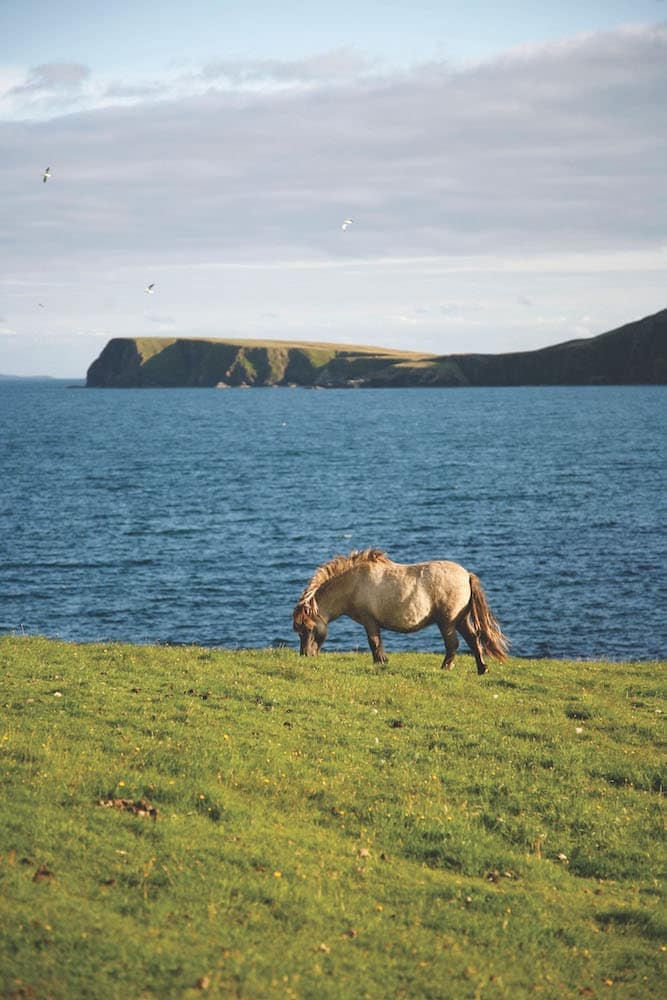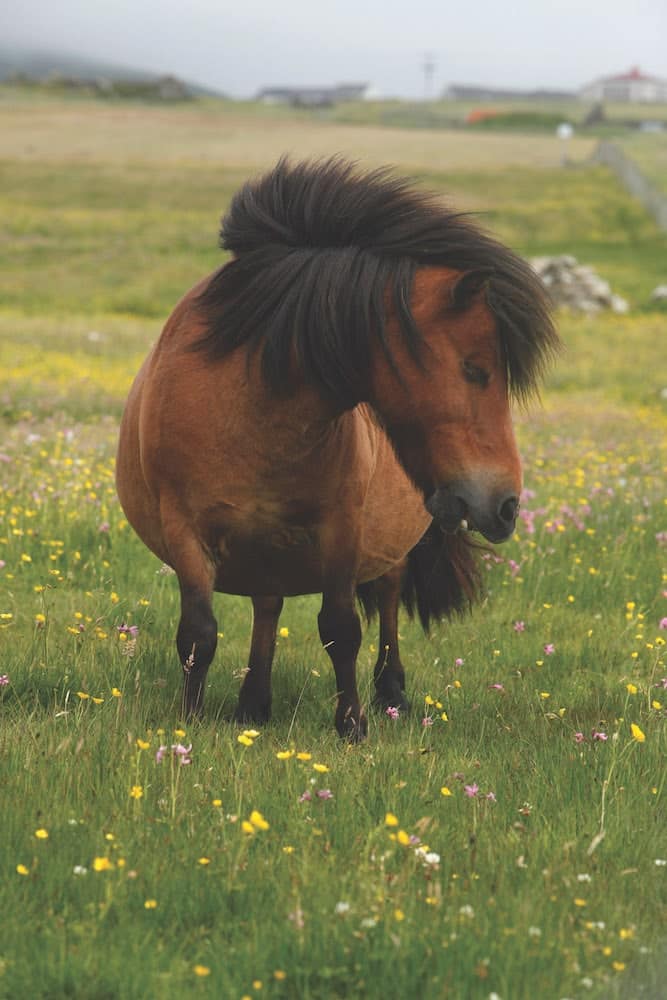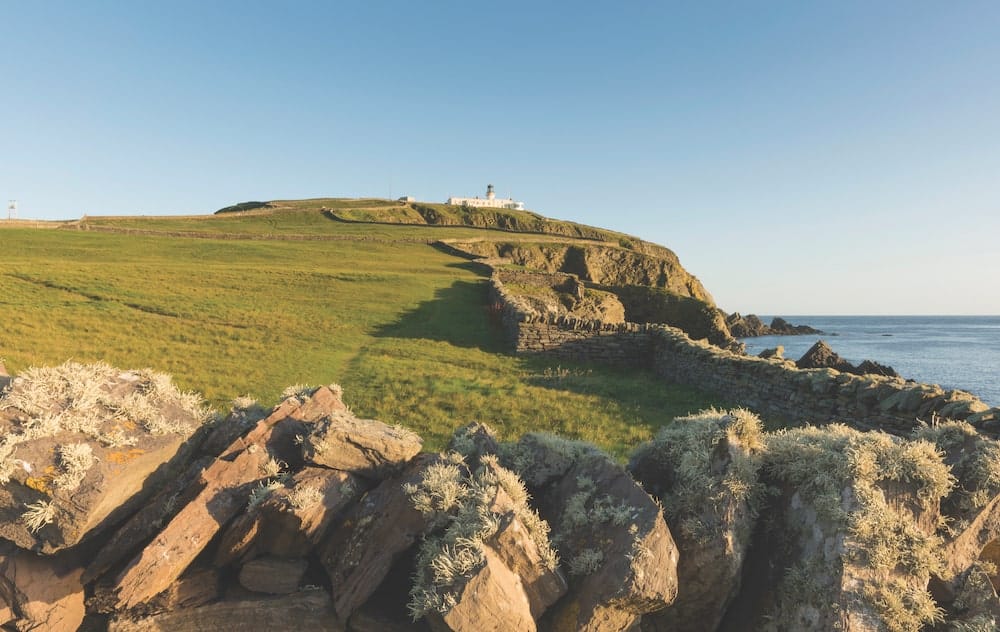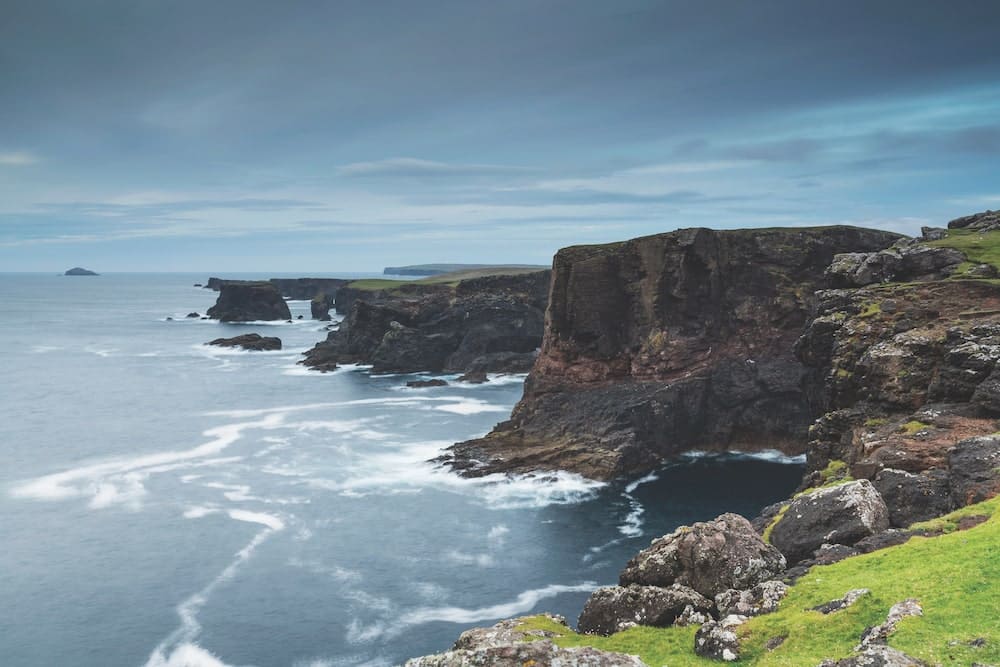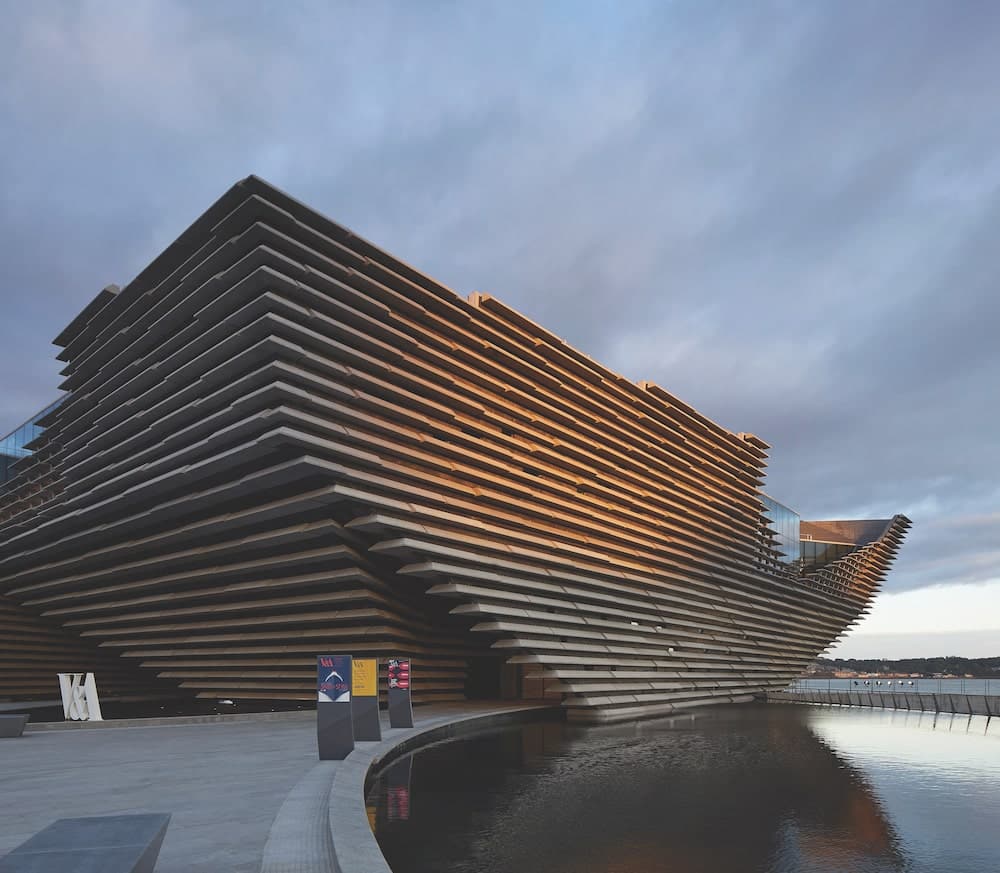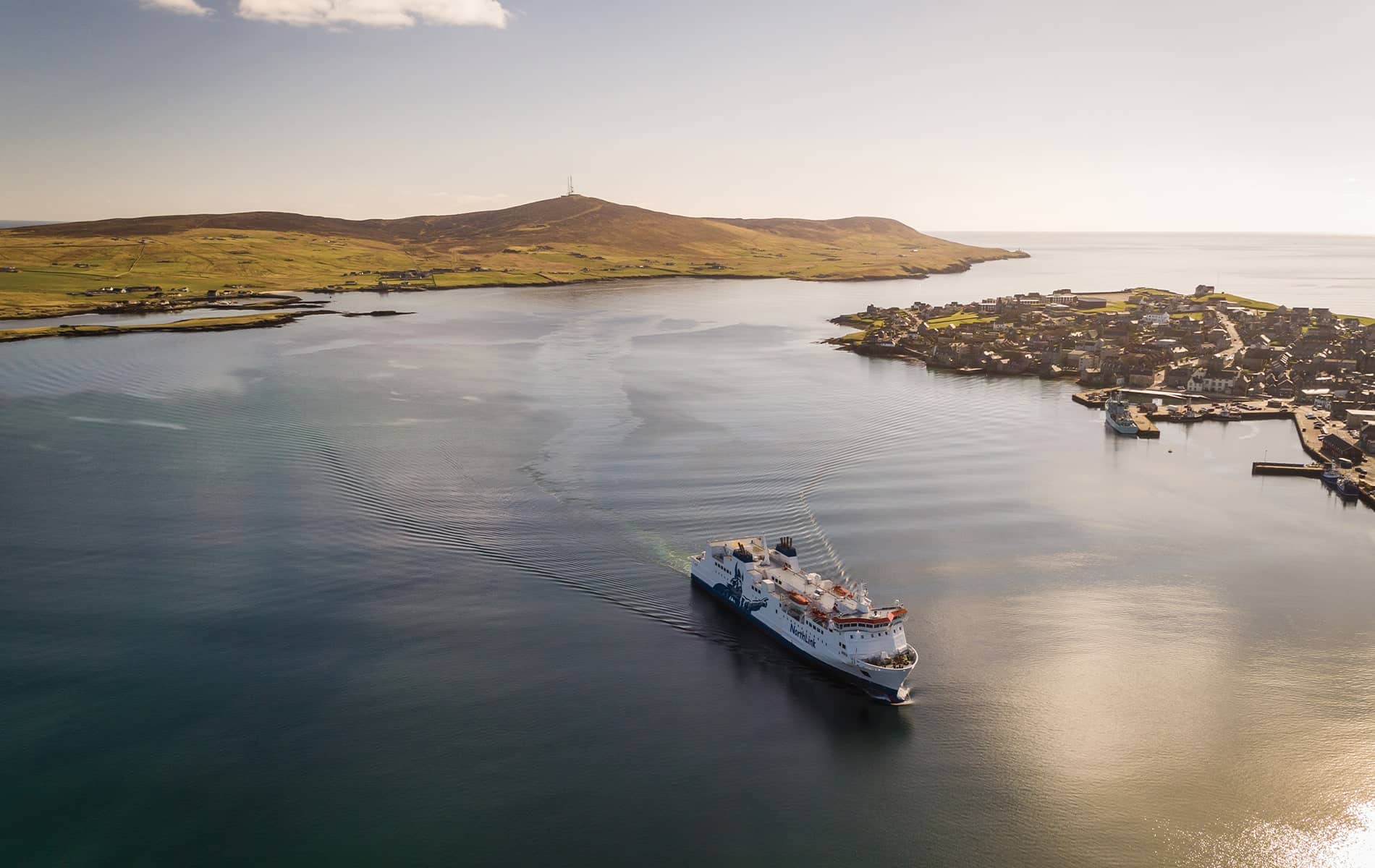
vie-magazine-shetland-united-kingdom-travel-hero-min
NorthLink Ferries shuttles visitors and locals between mainland Scotland and the Northern Isles of Orkney and Shetland. | Photo courtesy of NorthLink Ferries
Islands of Opportunity
A Celtic Getaway Like No Other
By Anthea Gerrie
So much space, so much green bleeding into blue and silver water—and so many creatures great and small abound in Shetland. There are 150,000 sheep, nearly seven times as many as the human population, with herds of longhorn cattle and miniature island ponies swelling the livestock contingent. And such a wealth of surprises—jewelers, weavers, artists, and other creatives hide within the farthest-flung nooks, nocturnal fiddles punctuate the blessed silence of serene, slow-moving days, and a spaceport will soon sit alongside Viking and Bronze Age relics on the far northern tip of this northernmost UK outpost.
The remoteness is a big part of the attraction of this stunning archipelago: Shetland is closer to the Norse lands with which it once shared a king and language than the Scottish capital that governs it today. But don’t confuse geographical distance with cultural isolation—I arrived for my third visit during an international film festival and was astonished to find the work of American photographer Diane Arbus showcased in the middle of a museum dedicated to island life and history.
Were it not for the life-size replica of a croft—the humble, low-lying dwellings whose residents have for centuries eked out a living tending their land and livestock—I would not have known I was in Scotland. With its absence of tartan, bagpipes, and surnames starting with “Mac,” Shetland is better known for the indigenous Fair Isle patterned knitwear and Celtic silver that have made its creative output famous worldwide. Travelers come for the natural wonders, historic landmarks, and the spectacular Up Helly Aa winter fire festivals celebrating the islands’ Viking heritage. Still, they find the bonus of retail therapy they may not have expected.
Shetland, the TV show based on Ann Cleeves’s best-selling crime novels, has put the islands on the map for an international audience and will shortly return to the screen, so the time to go is now. Soon, many cruise ships will disgorge passengers at Lerwick, the harbor capital, and the crowds will discover Unst, where the spaceport is due to be built. Despite its excellent maritime museum and heritage center, world-class sea bird breeding ground, medieval castle, and art glass studios, I had Unst to myself in late summer. The first rain after a week of sunshine made the long trek from the car park to the viewing decks at Hermaness Nature Reserve a tad daunting, especially as the puffins had just flown south for the season, but a good cuppa and giant homemade scone at Victoria’s Vintage Tea Rooms on the water provided a welcome warm-up. I never found Bobby’s Bus Shelter, elaborately dressed by an unsung decorator for the delight of locals. Still, I did see Viking longhouses and ancient standing stones and bought “peerie” (little) jewelry boxes from one of the island’s many honesty vending machines, this one set up to support Alzheimer’s research.
Given how much the Shetland mainland offers, taking two ferries to reach northernmost Unst is more than most visitors attempt. Lerwick, where cruise ships and the NorthLink overnight ferry from Aberdeen tie up, is charming and walkable, with plenty of cafes and shops along Commercial Street and live music on offer at different venues every night of the week. Grandmothers joined the men and boys raising their bows at the Lounge Bar opposite the tourist office, where I settled around the musicians’ circle for an hour with a generous measure of island single malt.
Travelers come for the natural wonders, historic landmarks, and the spectacular Up Helly Aa winter fire festivals celebrating the islands’ Viking heritage. Still, they find the bonus of retail therapy they may not have expected.
When restlessness kicks in for the wide-open spaces beyond Lerwick, a good tour operator is vital to discovering the unmissable sights beyond the capital. I joined a band of Americans, Brits, and Australians at Sumburgh Airport, located moments from the highlights of the southern mainland, where they had flown in to get a taste of Shetland with award-winning Scotland specialists McKinlay Kidd. The runway overlooks the prehistoric settlement of Jarlshof, where six thousand years of Shetland history are laid out in layered ruins, a logical first port of call for any visitor wanting to understand the islands’ story. Nearby, the elaborate lighthouse built by the grandfather of Treasure Island author Robert Louis Stevenson offers stupendous cliff-top views, and from St Ninian’s Isle at sea level, we looked out to the Atlantic on one side and the North Sea on the other, connected by just a spit of sand.
At Busta House Hotel, an atmospheric Jacobean mansion perched above the picturesque cove of Brae to the northwest, I cozied up in a canopied bed, feasted on the fresh catch for which Shetland is famous (the fishermen use the old Norn language inherited from their conquerors to wish each other good luck), and enjoyed a postprandial whiskey in the Long Room where Queen Elizabeth took tea in 1960. Next day we headed west and north to the breathtaking rocks of the Esha Ness Peninsula, the pretty marina at Voe, and the haunting old church of Lunna, a village famous for its “Shetland Bus” underground war effort (not buses at all, but a brave armada of small boats supporting the Norwegian Resistance during Nazi occupation).
Renting a car when the group departed made it possible to discover delights groups rarely reach, including the Shetland Textile Museum just north of Lerwick. This whetted my appetite for the real thing, found at Laurence Odie Knitwear’s studios, packed with sweaters and scarves in traditional patterns in far-out as well as more muted colors. Next door in the tiny hamlet of Hoswick is the silver atelier of Karlin Anderson, and there is more designer silver in Weisdale, on the road to the northern isles, which also showcases the best of Shetland design in an old mill with an excellent café.
I might not have thought of stopping on Yell—the bleak, sparsely populated intervening island on my way to Unst—but I was stopped in my tracks by its annual island show. The entire population appeared to have packed into the village hall with their homemade cakes, arts and crafts, and flowers exquisitely honed to their best for judging—like the prize livestock paraded in the pens outside—making a stop to admire the animals and their owners’ handiwork irresistible. Award-winning fish and chip fryers provided the catering and live fiddlers the soundtrack for an unexpectedly joyous slice of island social life, to which visitors were welcome. It seemed almost surreal to be back among the urban hordes a few hours later, after the overnight ferry from Lerwick and a surprisingly short rail ride by high-speed LNER train from Aberdeen to London.
— V —
For more information or trip-planning resources, visit Shetland.org, McKinlayKidd.com, and NorthlinkFerries.co.uk.
A Cultural Pit Stop in Dundee
Visiting Shetland from England or mainland Scotland by train and ferry offers the chance to visit Dundee, only an hour south of Aberdeen and home to the fabulous new building that hosts the Scottish outpost of the Victoria and Albert Museum. Designed by a Japanese architect inspired by an Orkney rock formation, V&A Dundee sits right on the shore beside the RRS Discovery, Captain Scott’s famous Antarctic expedition ship. The two are a thirty-second walk from the waterfront station. On the far side of the museum (fielding a world-class exhibition about tartan through mid-January), a unique sensory garden offers walks among sounds of the sea, with separate gardens aglow with colored glass and dancing fountains.
To the other side, also one minute from the station—and just two from the V&A—is the Malmaison, a local outpost of the quirky British boutique hotel chain famous for its moody colors and semi-industrial vibe. The DCA Contemporary Arts Centre is walkable from here, where you can find a map of the city’s street art in the groovy shop. The Verdant Works, an old mill where Dundee’s textile history comes to life, and the eclectic Broughty Ferry restaurant, bar, and shopping scene east of the city center are also considered must-sees for those who can spare two nights for a side trip.
Visit VAM.ac.uk/dundee to learn more or purchase passes.
Share This Story!
KEEP UP WITH THE LATEST STORIES FROM VIE



